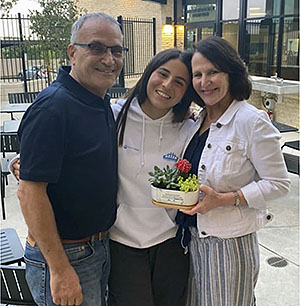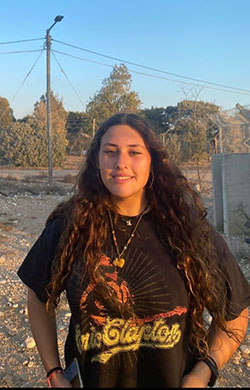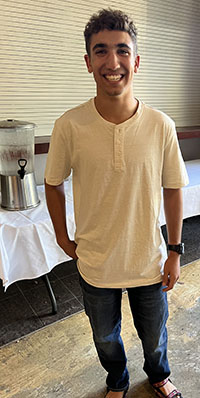By Donald H. Harrison

SAN DIEGO – Ten Israeli high school graduates, taking a gap year before they enter the Israeli Army (IDF), have been placed around San Diego County through the cooperation of the Jewish Agency for Israel (JAFI) and the Jewish Federation of San Diego County.
Their mission is to spread knowledge about Israel and the Hebrew language to school children in day schools; supplemental synagogue schools; the Kovod School, a public charter school where students learn in both English and Hebrew; and at a variety of other Jewish groups and institutions.
While on assignment in San Diego, the students known collectively as shinshinim (singular masculine is shinshin; singular feminine is shinshinit) reside in the homes of San Diego County residents initially for a period of three months, which can be extended if mutually agreeable to the host families and the shinshinim.
These teenaged ambassadors from Israel are provided cars and cell phones by the Jewish Agency, so a host family’s responsibilities are to provide a place to sleep, some food, and such social activities as naturally occur within the family.

Last year, Debbie and Sol Kempinski hosted Peleg Menachem from the village of Zoran, Israel, which is close to the city of Netanya. Peleg since has returned to Israel, but the memories of her visit stay with Debbie, who is the associate development director at the San Diego Jewish Academy, and Sol, who is the director of philanthropy for Jewish Family Service of San Diego.
Peleg was assigned to the San Diego Jewish Academy on weekdays and to the Ken Jewish Community on Saturdays. During the summer, she worked locally at the Ken Camp and at Camp Jaycee.
Debbie Kempinski recalled that Peleg would make her own breakfast as well as a lunch to take to work, and “we would do dinner together several times a week, and we really enjoyed that. She worked really hard. She was really committed to making a difference in our San Diego Jewish community. She was very idealistic and came with a lot of energy in a great way, and really wanted to give a year of herself and her love of Israel.”
“From our side,” Debbie continued, “she was lovely. She was interested in life in America and San Diego. She enjoyed having time with us. … We knew the community needed the support and my husband Sol and I thought, ‘they need hosts, we have empty bedrooms, let’s do it!’ It was nice to have someone in the house.”
The Kempinski family and Peleg regularly had Friday night Shabbat dinner together and occasionally attended Conservative services at Congregation Beth Am. “A highlight that she told us about was our Passover seder,” Debbie said. “My husband makes his own Haggadah each year and puts a lot of thought into our seder. She really enjoyed it. She took a Haggadah home. We print them every year and guests take them, so she did, and she said on a group video that was a highlight for her.”
Among the cohort of shinshinim this year are Yarden Shahar from Kibbutz Or Haner in the Sha’ar Hanegev municipality and Shay Tsuk from Mazkeret Batya, near Rehovot and approximately 10 miles from Tel Aviv.

In that Sha’ar Hanegev is the partnership region for the Jewish Federation of San Diego, Yarden had more than a passing acquaintance with San Diego. During her high school career, she participated in a Zoom program that brought together students from Sha’ar Hanegev, San Diego, and Sofia, Bulgaria. “This was how I got to know San Diego and I knew that this was our sister city,” Yarden told me. “I didn’t know a lot about it, but I had information about it.”
“The connection is strong,” she added. “If you live in Sha’ar Hanegev, you cannot not know about San Diego.”
Yarden’s English is quite good and her Israeli accent less pronounced than Shay’s. One reason for that is that her paternal grandparents are Americans from Philadelphia – one of the cities that she visited as a tourist last year along with New York, Tampa, Orlando, and Miami. Visiting tourist attractions like the Empire State Building and Universal Studios is quite different than living with an American family in San Diego, she pointed out. “I did not go to Target, or shopping for food, or meeting friends, or needing to adjust.”
Yarden will divide her time between San Diego Hebrew Day School and Congregation Beth El.
As she hadn’t yet met with her supervisors at Beth El when I interviewed her, I asked her to describe her anticipated interactions with students at the Hebrew Day School, where classes go from preschool through 8th grade.
Generally, she said, she will be “bringing my Israeli perspective, teaching them about Israel, how I experienced it, things I love about it, and passing my Israel to them.” In addition, she will be “teaching them Hebrew so they can get more comfortable with language. Most of the people who speak Hebrew are Jewish so that is a way that we can expand the Jewish world.”
She said she and her advisors have set a goal for her to met “an hour a week in every class.”
“I have a half hour one day in a class, a half hour another day, and we meet with the teachers to divide up the schedule.”
Working with students is not new to her. “I volunteered in the youth movement of the kibbutzim,” she saidl “I was a madrikha (youth counselor) for years there, and before that I was volunteering in the kibbutz kindergarten.”
She said she has devised activities to provide the various classes with “a fun way or a better way to look at Israel and Hebrew.”
“For example,” she explained, “I will go to the 4th grade, say ‘Hi everybody, what’s up?’ and talk about the cities in Israel, nature in Israel, things that are fun. I will be giving them a scavenger hunt about it, making it fun for them in those subjects.”
She says she has different activities planned depending on the grade level.
Yarden’s host is Amparo Goldman, who lives in Santee and is a member of Tifereth Israel Synagogue. Goldman’s daughter, Danielle Weizman, who lives in La Mesa with her husband David and two children, ages 9 and 7, meanwhile is hosting Shay Tsuk. The Goldman/ Weizman clan, along with the two shinshinim, have enjoyed Shabbat dinner together.
Goldman is a native of Colombia, who immigrated to this country when she was 18. She said she understands how challenging it can be as a teenager to absorb a new culture far from familiar surroundings. Clearly charmed by Yarden, Goldman enthused: “When she smiles it is beautiful! She loves her family. The way that girl speaks about her mother, it is magnificent. I’ve never seen any girl speak about her mother the way she does. It is so beautiful.”
Tsuk is assigned to Tifereth Israel Synagogue as well as to the Israeli-American Council and the Kavod Charter School, where many of the students are not Jewish but wish to learn Hebrew.
In some cases, such as the Kavod school, Congregation Beth El, the House of Israel, and the Israel-American Council, more than one shinshin has been assigned.

Tsuk told me that his town is quite different from San Diego. It is not unusual in the quiet setting of Mazkeret Batya for students to go out on weekend nights at midnight, ride their bikes, hang out, and return home at 4 a.m., he said. In contrast, activities in San Diego seem to conclude each night around 10 p.m. or 11 p.m., he said.
In Israel, Tsuk played guitar well and violin rarely. He was part of an informal band and was dedicated to hiking, working out, and hanging out with his friends. His father is a mechanical engineer, his mother a psychotherapist, and he has three siblings: a brother, 21, now in the IDF; a sister, 14, now in ninth grade, and a brother, 10, now in sixth grade.
He applied for the shinshinim program “both for public opinion and I truly believe that it is my duty to maintain the Jewish morale around the world,” he told me in Hebrew translated by Israeli-American Shahar Masori. “I’m here to strengthen the connections between the United States and Israel,” he said.
Like Yarden, he said, “I am going to describe the way that I grew up, the culture, the way my parents raised me. I will try to enrich everybody here with everything that I have learned throughout my life, the values and the culture of Israel.”
This is Shay’s first time in the United States. Among his first impressions is that drivers in San Diego County “are far more chill” than Israeli drivers. “Everything can wait.”
He commented that “it is weird to live with a foster family when you are going to a house full of people you don’t know for not a short period. I think it is going to be three months, but it might be longer. You need to make yourself feel at home. It is just a weird feeling. To make yourself comfortable takes some time, using things that are not your own; that is the kind of sensation I’ve had.”
“But,” he continued, “I think anyone who is willing to open the door is a very good person in my book. I was extremely fortunate that the family that hosted me are just incredible. They are generous, kind; they truly make me feel like I’m one of their own. David is a great guy. We share things in common like our love for cars, building stuff, remodeling, technical stuff.”
“It all comes down to the kind of environment you are in, and I got lucky,” he added.
I asked what he hoped to learn or gain from this experience.
“I would love to learn as much as possible here that I won’t have the opportunity to in Israel – the culture – and to feel that what I did here was significant and made a difference. I want to give a lasting impression and affect a future generation, so this program will involve more people from both countries. It is important to me to do something in which I believe wholeheartedly, and I do.”
The other eight shinshinim and the institutions to which they have been assigned are:
Gal Attia: Congregation Beth El and Kavod.
Yinnon Becker: Congregation Beth Israel, House of Israel, and Seacrest Village.
Daniel Evenpaz: Israeli-American Council, Kavod, Temple Emanu-El
Noam Kieselstein: Kavod, Ohr Shalom, Tzofim (Friends of Israel Scouts)
Keren Mittler: Congregation Beth Am, San Diego Jewish Academy, and Tzofim
Adi Waksman: Chabad Hebrew Academy, Ken Jewish Community, Temple Emanu-El Preschool, Israeli-American Council
Noya Zager: Chabad of East County, House of Israel, Kavod.
Ofri Ziv: Israel-American Council, Lawrence Family JCC
*
Donald H. Harrison is editor emeritus of San Diego Jewish World. He may be contacted via donald.harrison@sdjewishworld.com